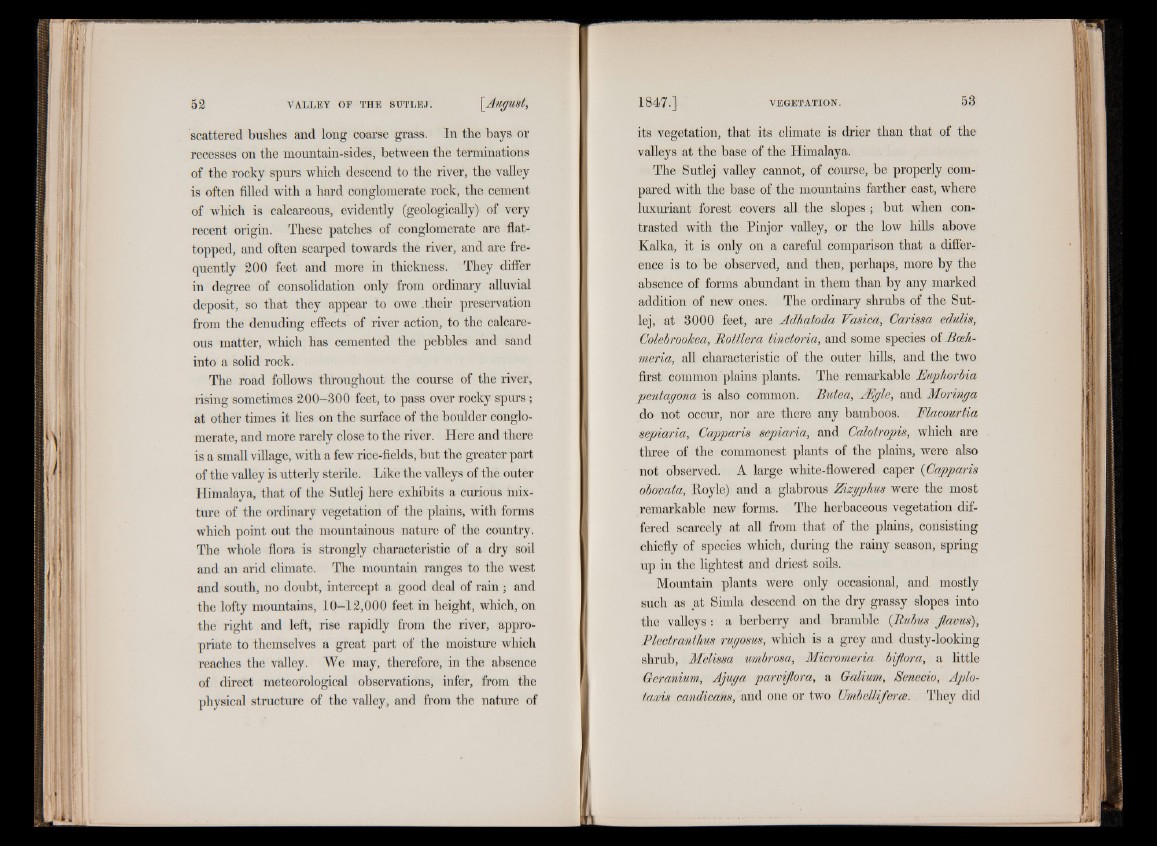
scattered bushes and long coarse grass. In the bays or
recesses on the mountain-sides, between the terminations
of the rocky spurs which descend to the river, the valley
is often filled with a hard conglomerate rock, the cement
of which is calcareous, evidently (geologically) of very
recent origin. These patches of conglomerate are flat-
topped, and often scarped towards the river, and are frequently
200 feet and more in thickness. They differ
in degree of consolidation only from ordinary alluvial
deposit, so that they appear to owe .their preservation
from the denuding effects of river action, to the calcareous
matter, which has cemented the pebbles and sand
into a solid rock.
The road follows throughout the course of the river,
rising sometimes 200-300 feet, to pass over rocky spurs;
at other times it lies on the surface of the boulder conglomerate,
and more rarely close to the river. Here and there
is a small village, with a few rice-fields, but the greater part
of the valley is utterly sterile. Like the valleys of the outer
Himalaya, that of the Sutlej here exhibits a curious mixture
of the ordinary vegetation of the plains, with forms
which point out the mountainous nature of the country.
The whole flora is strongly characteristic of a dry soil
and an arid climate. The mountain ranges to the west
and south, no doubt, intercept a good deal of rain ; and
the lofty mountains, 10-12,000 feet in height, which, on
the right and left, rise rapidly from the river, appropriate
to themselves a great part of the moisture which
reaches the valley. We may, therefore, in the absence
of direct meteorological observations, infer, from the
physical structure of the valley, and from the nature of
its vegetation, that its climate is drier than that of the
valleys at the base of the Himalaya.
The Sutlej valley cannot, of course, be properly compared
with the base of the mountains farther east, where
luxuriant forest covers all the slopes; but when contrasted
with the Pinjor valley, or the low hills above
Kalka, it is only on a careful comparison that a difference
is to be observed, and then, perhaps, more by the
absence of forms abundant in them than by any marked
addition of new ones. The ordinary shrubs of the Sutlej,
at 3000 feet, are Adhatoda Vasica, Carissa edulis,
Colebrookea, Rottlera tinctoria, and some species of Bosh-
meria, all characteristic of the outer hills, and the two
first common plains plants. The remarkable Euphorbia
pewtagona is also common. Butea, AEgle, and Moringa
do not occur, nor are there any bamboos. Flacourtia
sepiaria, Capparis sepiaria, and Calotropis, which are
three of the commonest plants of the plains, were also
not observed. A large white-flowered caper (Capparis
obovata, Royle) and a glabrous Zizgphus were the most
remarkable new forms. The herbaceous vegetation differed
scarcely at all from that of the plains, consisting
chiefly of species which, during the rainy season, spring
up in the lightest and driest soils.
Mountain plants were only occasional, and mostly
such as at Simla descend on the dry grassy slopes into
the valleys : a berberry and bramble (Bubus Jlavus),
Plectranthus rugosus, which is a grey and dusty-looking
shrub, Melissa umbrosa, Micromeria bijlora, a little
Geranium, Ajuga parviflora, a Galium, Senecio, Aplo-
taxis candicans, and one or two Umbelliferce. They did